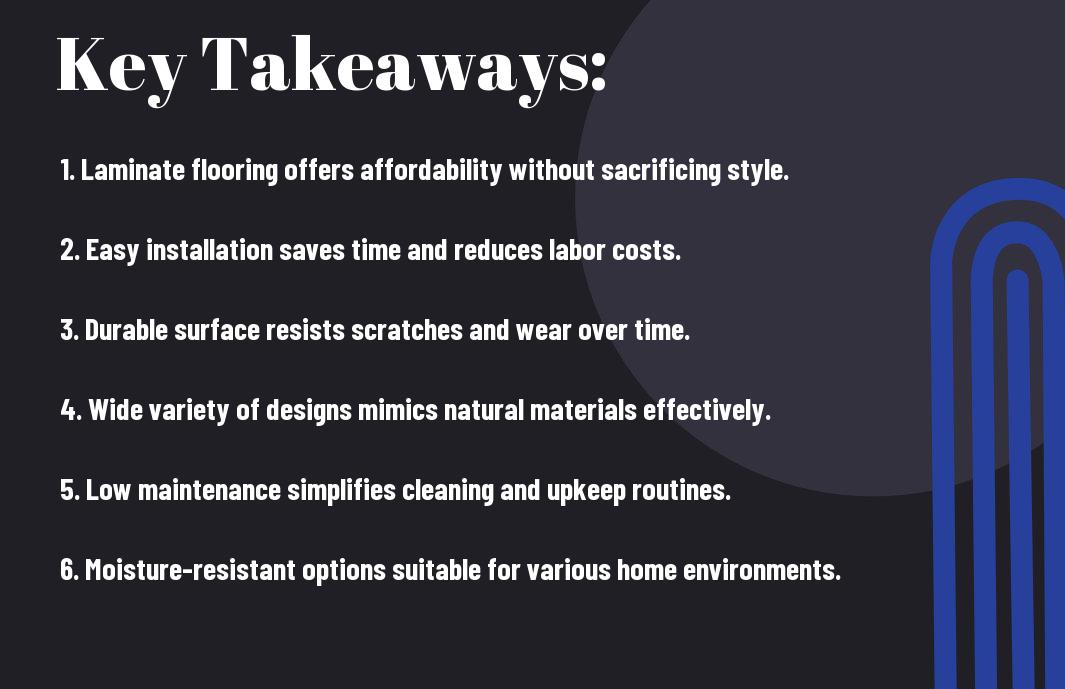Options for flooring can seem overwhelming, but laminate flooring offers a compelling choice that deserves your attention. With its impressive durability, aesthetic versatility, and cost-effectiveness, laminate flooring can enhance the look and feel of any space in your home. In this blog post, you will explore the unique features of laminate flooring that set it apart from other flooring types, helping you make an informed decision for your next renovation or build.

Overview of Flooring Options
A variety of flooring options are available to suit your needs, style, and budget. From traditional hardwood and elegant tiles to practical vinyl and innovative laminate, each type offers unique advantages. This multitude of choices allows you to find the perfect match for your home’s aesthetic and functionality. Below are some common types of flooring materials.
Types of Flooring Materials
Flooring options come in various materials, each with distinct characteristics that can enhance your living space.
| Type | Description |
|---|---|
| Hardwood | Natural timber with a classic, timeless appeal. |
| Tile | Durable and available in countless designs and colors. |
| Vinyl | Water-resistant and budget-friendly flooring option. |
| Carpet | Soft and warm underfoot, ideal for cozy spaces. |
| Laminate | Affordable and versatile, mimics the look of wood. |
Any of these materials can dramatically impact the look and functionality of your home.
Pros and Cons of Each Option
Option analysis of flooring materials provides insight into their respective benefits and drawbacks, helping you make informed decisions.
| Pros | Cons |
|---|---|
| Hardwood: Durable, timeless beauty | Expensive, can scratch and dent |
| Tile: Water-resistant, easy to clean | Cold and hard underfoot |
| Vinyl: Cost-effective, versatile styles | Can fade in sunlight, less durable |
| Carpet: Cushioning, noise reduction | Stains easily, requires regular maintenance |
| Laminate: Budget-friendly, easy installation | Less authentic feel, may warp in moisture |
Another careful assessment of the pros and cons of flooring options enables you to choose the best fit for your lifestyle. While hardwood offers durability and a rich aesthetic, its high cost can be a limiting factor. Tile’s easy maintenance is appealing, but it risks being uncomfortable in colder climates. Vinyl is great for budget-conscious consumers, although it may require replacement sooner than other materials. Carpet provides warmth and comfort, yet demands more upkeep. Laminate’s affordability and practicality stand out, but its susceptibility to moisture damage should not be overlooked.
What is Laminate Flooring?
While exploring flooring options, you may come across laminate flooring, a popular choice known for its durability and aesthetic appeal. It mimics the look of natural wood or stone, offering a versatile design solution for various interior styles without the high cost associated with traditional materials. Laminate flooring is composed of several layers fused together, making it not only attractive but also resistant to scratches, stains, and wear, perfect for busy households.
Composition and Manufacturing Process
Below, you’ll find a breakdown of laminate flooring’s composition and the manufacturing process that results in its unique structure:
| Layer 1 | Wear Layer – Provides protection against scratches and stains. |
| Layer 2 | Design Layer – Features the printed image that simulates wood or stone. |
| Layer 3 | Core Layer – Made of high-density fiberboard, offering stability. |
| Layer 4 | Backing Layer – Serves as a moisture barrier and enhances durability. |
Types of Laminate Flooring
Above, you will find various types of laminate flooring, which cater to different tastes and needs:
| Standard Laminate | Offers a basic look and feel, suitable for any room. |
| Water-Resistant Laminate | Designed to withstand moisture, ideal for kitchens and bathrooms. |
| Textured Laminate | Features a textured surface that enhances grip and appearance. |
| Luxe Laminate | High-end option with authentic visuals and extra durability. |
Due to the wide range of styles and finishes available, laminate flooring can suit any design preference. When considering your options, look for features like:
- Thickness, as thicker laminate often provides better sound insulation.
- Style and texture, which can dramatically change the feel of your space.
- Water resistance, crucial for areas prone to moisture.
- Durability ratings, which indicate how well the flooring will hold up over time.
The variety of laminate flooring options available allows you to find the perfect fit for your home, ensuring longevity and style.
Advantages of Laminate Flooring
Unlike other flooring options, laminate flooring combines a range of benefits that make it a popular choice among homeowners. With its exceptional durability, ease of maintenance, cost-effectiveness, and aesthetic appeal, laminate flooring ensures that you make a wise investment in your home. This versatile flooring solution meets various needs and complements any interior design style, allowing you to enjoy a beautiful and functional space.
Durability and Maintenance
Around your home, laminate flooring stands out for its durability. It is resistant to scratches and dents, making it an excellent choice for high-traffic areas. Additionally, its non-porous surface makes it easy to clean with just a damp cloth, eliminating the need for specialized cleaning products. You can enjoy the beautiful look of laminate without the extensive maintenance required by other flooring types.
Cost-Effectiveness
Above all, laminate flooring offers an affordable solution for those on a budget. Compared to hardwood or natural stone options, laminate provides a similar aesthetic at a fraction of the cost. This means you can achieve the desired look for your home without sacrificing quality or breaking the bank.
In fact, investing in laminate flooring not only saves you money upfront but also reduces long-term costs related to maintenance and repair. Its durability and resistance to wear and tear mean you won’t have to frequently replace or repair your floors, allowing you to allocate funds to other home improvement projects.
Aesthetic Appeal
With a vast array of styles, colors, and finishes available, laminate flooring can seamlessly match your personal taste and interior design. Whether you prefer the look of rustic wood or sleek modern tiles, there is a laminate option for you that will elevate your space.
Considering the advancements in manufacturing technology, laminate flooring has come a long way in terms of realism. High-definition prints and textures make it virtually indistinguishable from natural materials, enabling you to achieve your dream home design while enjoying the practical benefits of laminate. You can create a stunning environment that reflects your unique style without compromising on quality.
Installation Process of Laminate Flooring
Many homeowners appreciate the straightforward installation process of laminate flooring, which allows you to achieve a beautiful new look with minimal hassle. With the right materials and a bit of preparation, you can efficiently lay down your laminate planks, transforming your space in no time.
Preparation Steps
On your journey to install laminate flooring, start with gathering all necessary tools and materials. Ensure your subfloor is clean, dry, and stable, addressing any imperfections. It’s also wise to acclimate your laminate planks in the room for at least 48 hours, allowing them to adjust to the environment before installation begins.
Installation Techniques
One effective technique for installing laminate flooring is the floating method, where planks interlock without being adhered to the subfloor. This method allows for easy removal and replacement in case of damage. Additionally, ensure you leave an expansion gap around the perimeter to accommodate seasonal changes, which is key for maintaining the integrity of your flooring.
It’s important to work in a staggered pattern when laying the planks to create a more natural and visually appealing look. Start from one corner of the room and proceed row by row, using spacers to keep that necessary expansion gap. As you interlock the planks, tap them gently with a tapping block to secure them in place, ensuring a tight fit. Proper alignment and attention to detail during this stage will result in a flawless finish you can enjoy for years.

Comparing Laminate Flooring to Other Options
Not all flooring options are created equal, and understanding the differences can significantly influence your choice. The comparison between laminate flooring and other types of flooring can help you identify what best suits your needs. Below is a breakdown of key comparisons:
| Flooring Type | Comparison |
|---|---|
| Laminate vs. Hardwood | More affordable, easier installation, less susceptible to scratches. |
| Laminate vs. Carpet | More durable, easier to clean, available in various styles. |
Laminate vs. Hardwood
About laminate flooring, it is often considered a budget-friendly alternative to hardwood. While hardwood boasts natural beauty and longevity, laminate provides a similar appearance at a fraction of the cost, along with higher resistance to wear and tear.
Laminate vs. Carpet
Other flooring options, like carpet, may offer comfort underfoot, but they can be challenging to maintain. Laminate flooring provides a chic aesthetic while being highly durable and much easier to clean.
Understanding the differences, laminate flooring is easier to maintain than carpet. It is resistant to stains and doesn’t harbor allergens, making it a healthier option for your home. With a wide array of designs, laminate can effectively mimic the look of carpet or any other flooring type, ensuring you don’t have to compromise on aesthetics for practicality.
Common Misconceptions about Laminate Flooring
Keep in mind that laminate flooring is often misunderstood. Many people believe it is a low-quality option that won’t stand up to the test of time or wear. In reality, modern laminate flooring is designed with durability in mind and can offer excellent performance and aesthetic appeal. Understanding these misconceptions can help you make an informed decision when selecting flooring for your space.
Longevity Myths
After years of innovation, laminate flooring has evolved significantly. Many assume it doesn’t last long, but high-quality laminate can withstand heavy foot traffic and maintain its appearance for many years. With proper care and maintenance, it can provide a reliable flooring solution that rivals more expensive materials.
Environmental Impact
Beside misconceptions about durability, the environmental impact of laminate flooring is often questioned. While some may think laminate contributes to deforestation or is harmful to the environment, many manufacturers now use sustainable practices and eco-friendly materials in production.
Common laminate flooring options are made from recycled materials and adhere to stringent environmental standards. Brands increasingly prioritize sustainability, ensuring that your flooring choice minimizes its ecological footprint. This includes using low-VOC finishes and adhesives that reduce harmful emissions. As you explore laminate flooring, you’ll find options that align with your values regarding environmental responsibility.


